… to do anything right now. This afternoon, the temperature on the thermometer on the van showed 41°C at one point and that was confirmed by one of these roadside thermometers so I’m sure that it was correct.
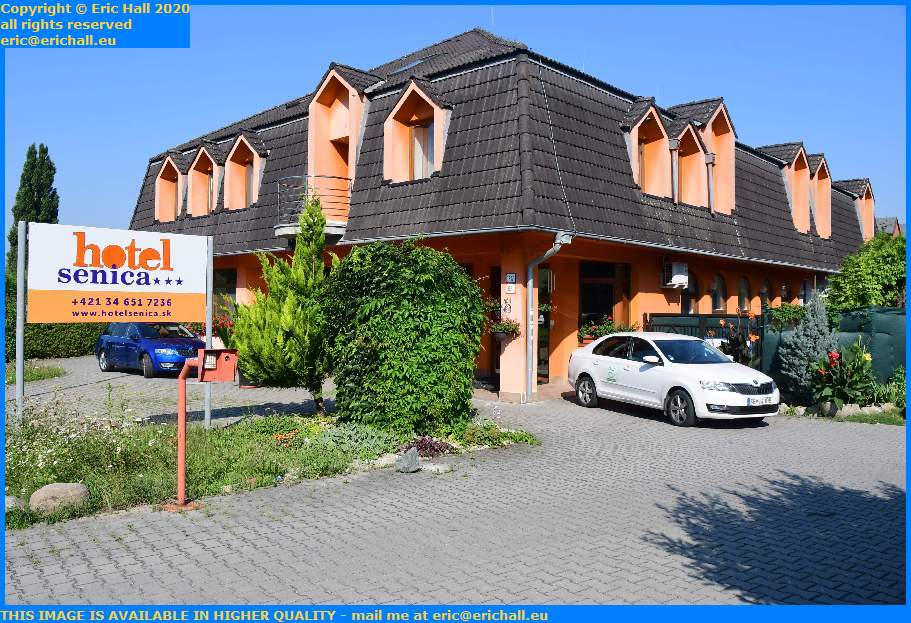 Last night was a really good sleep, and I slept right up to 05:47 when something awoke me – but I’m not sure what.
Last night was a really good sleep, and I slept right up to 05:47 when something awoke me – but I’m not sure what.
Nevertheless, I didn’t actually leave the bed at that time but … errr … somewhat later.
According to the dictaphone, I’d been on my travels too during the night. I had been going somewhere, driving and I was in Caliburn, I think. I was being followed by an old Morgan 3-wheeler with a couple in it, driven by a guy with a red handlebar moustache. They were piled up with luggage and seemed to be following me throughout all of my route across Central Europe and it was very interesting although I didn’t exchange a single word with them or anything like that and it was very intriguing to try to work out exactly what they were doing
And later on it was Welsh Cup day and there were 12 matches being played. 2 were postponed and some were being played later. We were going to go to Aberystwyth to watch the game. They were talking about this on the TV and radio which was nice. I was in Nantwich somewhere so I set off to walk. I got to round about Gresty, somewhere like that and there was a football stadium and there was quite a big queue outside. I climbed over the fence to get in, about 12′ high and I’m not quite sure why I would do that. I was hoping to meet the others, including my father apparently and we’d all go into the ground together. For some unknown reason it was half an hour to kick-off and I couldn’t find them at all. I wondered what had happened to them.
Having organised myself and packed my stuff, I said goodbye to my nice hotel and set off.
First port of call was the Billa Supermarket down the road where i bought some food for the journey – including some grapes. And bread was cheap too here in Slovakia, as I discovered.
Another thing was that I was impressed with the range of vegan food on offer – much better than anything that France could come up with in a mainstream village supermarket.
It’s a shame that I’m leaving the country today. I’ve always liked Slovakia. I spent several weeks here in the North-East of the country on the Polish border when I worked with Shearings and one of these days I’ll try to find the time to spend much more time here.
Having done the shopping for the next couple of days (I can’t buy too much and expect it to survive long in this heat) I set off and drove all the way south-eastwards through the mountains.
Driving through the town of Boleraz I had to do a U-turn and go back to check on something that I’d seen in someone’s garden here.
One thing that’s disappointed me is the absence of real Eastern European cars around here. No Gaz or ZIL vehicles, only one Skoda and not even any Moskvitches either come to that. I can’t believe that a whole lifetime of interesting vehicles has been wiped out of existence.
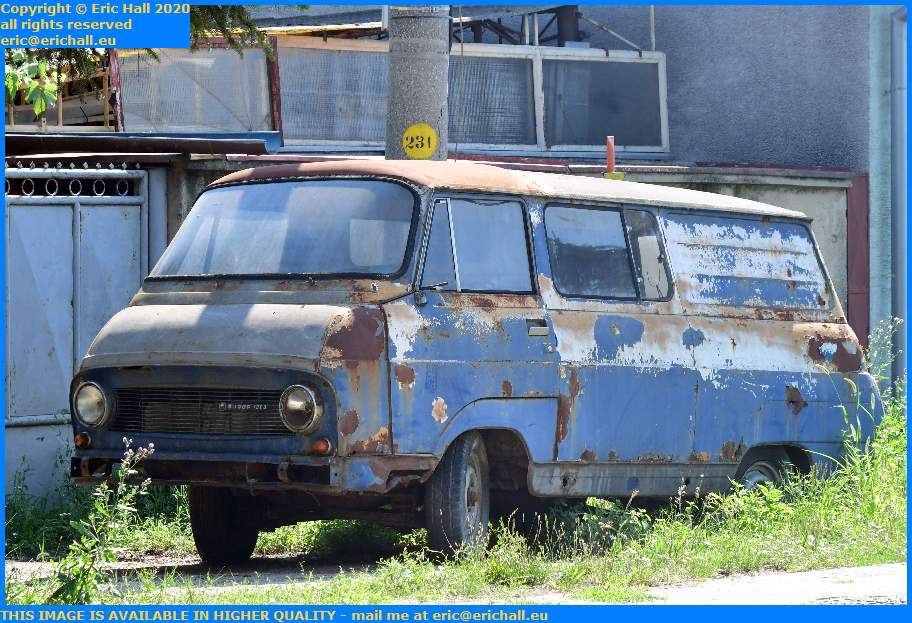 And so when I saw this old Skoda 1203 I breathed a sigh of relief.
And so when I saw this old Skoda 1203 I breathed a sigh of relief.
This was Eastern Europe’s equivalent of the Ford Transit. Every businessman or tradesman owned one and they were the local ambulances and police vans too. You used to find them everywhere 30 years ago, but so far on my travels I’ve only seen one of them prior to this and that was on the road heading the other way.
Not that I would swap Caliburn of course, but I would love to take something like this back home with me to have some fun. It’s a real relic of the past, that’s for sure, and quite a curio too.
 By-passing Bratislava, I ended up in the town of Velky Meder on the border with Hungary.
By-passing Bratislava, I ended up in the town of Velky Meder on the border with Hungary.
A railway like runs through the town and there’s a railway station here so I reckoned that I would go along and see what was happening her. And my luck was in because there was a goods train here in the siding.
The locomotive pulling it is an FOR type 742 – a heavy shunter built for Czech Railways and now used all over the Czech Republic and Slovakia for hauling small freight trains and on occasion even passenger trains. It’s painted in the livery of the Ostravská Dopravní Spolecnost – a freight logisitics company from Ostrava in the Czech Republic.
The railway station and the surrounding area have a very sinister reputation, something that is quite ironic seeing as currently back at home I’m reading a book about the Serbian nation in World War I.
After the collapse of the Serbian Army in 1915 the Serbian soldiers, as well as a great many civilians, who didn’t manage to escape to Greece were arrested and subjected to a most appalling savagery by the Austrian troops. A Prisoner-of-War camp or, to be more precise, a death camp was set up here and there are mass graves all over the area that contain the remains of the Dead.
No-one knows how many Serbians and Montenegrin troops lost their lives here but a monument nearby records the names of over 5,000e known to have died here. I wasn’t able to find the monument or any of the graves while I was here. My Slovak isn’t up to anything much – certainly not for asking about this.
But on another note, if you come this way, don’t go looking for a town called Velky Meder because you probably won’t see a sign for it. You’re more likely to see a sign for Nagymegyer.
That’s because although we are north of the Danube, the frontier between Slovakia and Hungary, this whole area for a considerable number of miles around is ethnically Hungarian but was occupied by Czech Nationalist forces at the end of World War I.
During the Nazi occupation of Czechoslovakia it was awarded to Hungary but recovered in 1945. Even despite the forced relocation of many ethnic minorities in the late 1940s the population is almost entirely ethnically Hungarian and almost everything is written in Hungarian.
So even had I been able to ask for the monument or the graves in Slovak, it probably wouldn’t have done me any good.
There was a LIDL in the vicinity so I stopped for a look around, and then crossed over into Hungary near the town at Gyor
Unfortunately there was nowhere suitable to park to take a photo of the border crossing so in due course I’ll pinch a still from the dashcam and post it. Even so, it’s more new territory for Caliburn and Strawberry Moose to visit.
Gyor was a nice place to drive around but there was nowhere to park and take a photo of the town. And in any case it was far too hot to go for a walk. I was melting.
 . In the end I found a nice sheltered spot by a small lake on the edge of town.
. In the end I found a nice sheltered spot by a small lake on the edge of town.
Here, wedged up in the shade between Caliburn and a hedge I ate my butty and afterwards did a little tidying up. And while I was here, I had a little snooze in the sun. I was at one point thinking about going for a walk in the sun but not in this temperature.
As an aside, I didn’t find out anything about this lake except that it’s one of about three or four in the immediate vicinity. And they all look very artificial to me although of course I wouldn’t know about that.
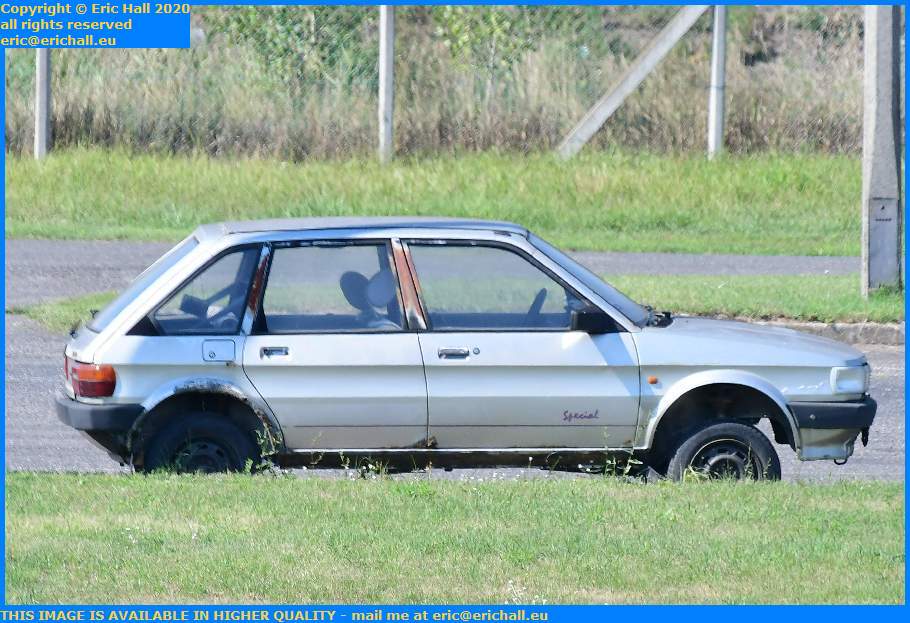 On the way to my parking place I’d seen a dirt road that crossed a railway line and then seemed to follow the river so I decided to go for a drive.
On the way to my parking place I’d seen a dirt road that crossed a railway line and then seemed to follow the river so I decided to go for a drive.
But I ended up stopping at the side of the road by an area that looked as if it might be a car park or something like that. For in there, parked and partially dismantled with no engine by the looks of things is an old Austin Maestro.
There are many vehicles that I would never expect to see in Eastern Europe, for sure, but the possibility of finding an Austin Maestro is something that I wouldn’t have ever considered. It’s certainly living up to its model name as a “Special” and I notice that it comes with factory-standard body rot.
 Further along the road I turned off, crossed the railway line and drove down as far as I could go until I reached the river, when I turned right to follow it for a while.
Further along the road I turned off, crossed the railway line and drove down as far as I could go until I reached the river, when I turned right to follow it for a while.
The river is the River Raba, a 300 kilometre long tributary of the Danube, and the part that I am following seems to be a canalised deviation of it. Where I’m driving looks as if it might be a service track on top of a levee and the amount of dust and gravel that I’m kicking up reminds me all too much of driving along THE TRANS LABRADOR HIGHWAY.
The road went for miles and I was reaching the stage where I was wondering whether I would have to turn around and go back the way that I came. However eventually I came to a house at the side of the track and wheeltracks of a couple of vehicles heading my way convinced me to carry on.
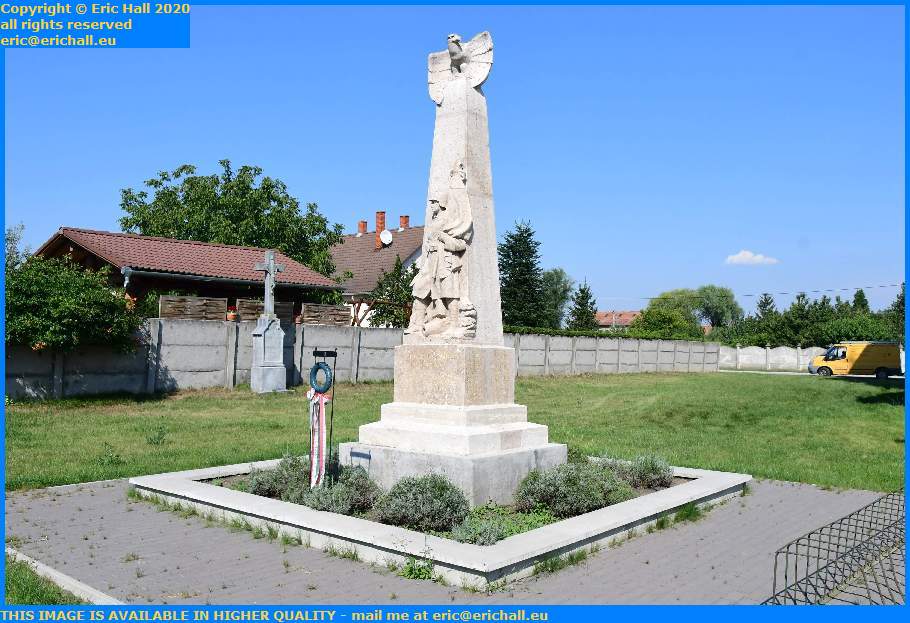 Eventually, having passed underneath a couple of other main roads that crossed the river on bridges, I came to an exit that brought me into the little town of Rabapatona.
Eventually, having passed underneath a couple of other main roads that crossed the river on bridges, I came to an exit that brought me into the little town of Rabapatona.
The road into the centre of the village brought me past the church and there, in the churchyard, was a war memorial so I went to have a look at it.
It lists the dead of the village for the two World Wars, so there’s nothing special about that. It might have been interesting to see the dead from other conflicts too.
But what really caught my eye was what wasn’t on the memorial. If you look closely at the base of the memorial there’s a patch of a different colour. It made me wonder if there had been something affixed there that is deemed today to be inappropriate. All kinds of shenanigans occurred with Hungary and its political partners between 1848 and 1990.
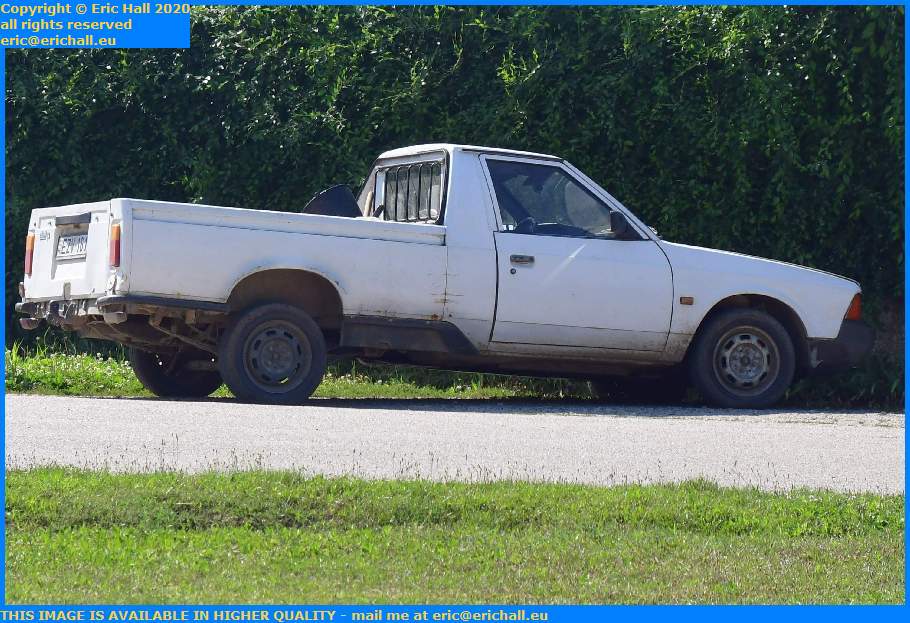 Having moaned on earlier in the day about the lack of old Eastern Bloc cars to be found these days, I struck it lucky in Rabapatona.
Having moaned on earlier in the day about the lack of old Eastern Bloc cars to be found these days, I struck it lucky in Rabapatona.
This exciting looking vehicle is a Moskvitch 2141 Aleko, built during the period 1986-1997. Based somewhat on the old French Simca 1307, the early models were said to have been some of the best cars ever to have come out of the Soviet Union although after the end of Communism, anarchy at the car plant led to a rapid deterioration of quality of the later ones.
Although the saloon cars were quite popular, I can say without fear of contradiction that this is the first ever Aleko pick-up that I’ve ever seen. I didn’t even realise that they were made.
Fighting off the heat (in mid-afternoon it reached 41°C according to two different thermometers) I found my way out of the town and into the countryside, disturbing a wedding as I drove through another small town.
And eventually I managed to track down a hotel – the Hotel Minerva in Mosonmagyarovar. Another lovely 3-star hotel at a bargain price and the first time that I’ve spent a night in Hungary since 1988.
First thing was to have a shower and wash of my clothes, and then I crashed out on the bed for a couple of hours. Rosemary awoke me with a phone call so we had a chat for a while, but I was too late to make any tea.
If the heat lets me, I’ll have a good sleep and then I’ll be ready to move on tomorrow.
Time to think about going home, I reckon.